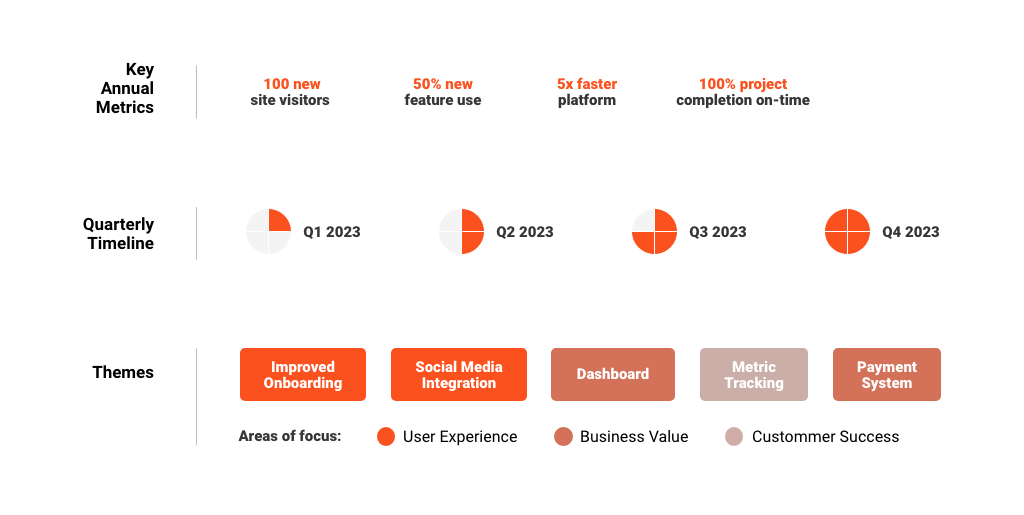
When it comes to building successful software, it’s essential to have a clear plan in place. This is where strategic planning and product roadmapping come in. Strategic planning involves setting goals and identifying the actions needed to achieve those goals. It helps businesses understand where they are going and how to get there. This information then translates into the actual activities related to product road mapping. Product road mapping involves identifying and prioritizing the features and capabilities based on your strategic plan. This article will explore the importance of strategic planning and product road mapping for software. We’ll examine how these processes can help organizations achieve their goals, stay focused, and build successful products. We’ll also discuss best practices for creating and maintaining a strategic plan and product roadmap. By the end of this article, you’ll better understand how to plan and execute your product vision effectively.
As we’ve mentioned, product road mapping is a crucial process for any software. But with so many potential options and feedback from stakeholders to consider, it can be overwhelming to create a roadmap that effectively communicates the direction of the product. That said, focus on four key steps and functions of the product roadmap:
Once you receive feedback from users, customers, and other stakeholders, it is time to build milestones and key metrics into your strategic plan. Your mission, vision, and values are what drive strategic planning activities. Without a strategic plan that considers your business’ mission, vision, and values, you may prioritize aspects of the product that could have otherwise been built later.
To begin, let’s define the mission, vision, and values:
Mission statement: Defines the purpose of your organization and the problem you’re trying to solve. It should drive your product roadmap, helping you stay focused on the most important goals.
Vision statement: Outlines where you want your organization to be in the future. It should be aspirational, guiding your long-term product strategy.
Values: The guiding principles that inform how you make decisions and conduct business. They should be reflected in the products and features you build and how you interact with customers and stakeholders.
By lining up your product roadmap with your mission, vision, and values, you can make sure you’re building a product that fits your organization’s purpose and will help you reach your long-term goals. The mission, vision, and values may evolve over time as you learn more about your product and your focus as an organization. Before completing the next steps, you must understand how to prioritize certain features based on evaluating risk and value (link to blog post).
Once you have your mission, vision, and value, you can create high-level goals for your business and product. Consider information from your customer discovery process, such as which customer pain points you are assisting in resolving. For example, you may be helping your customer scale their current processes. Additionally, consider desired outcomes based on your business needs, such as the number of new or retained customers. Based on this information, set a high-level timeframe. For example, you may want to accomplish these outcomes in 6 months.
Now that you have a high-level focus and timeframe, it is time to determine general themes, initiatives, timelines, and key metrics.

In summary, themes, timelines, and metrics are powerful tools for product road mapping, as they help organizations stay focused on high-level strategic plans, align with the goals and make it easy for internal and external stakeholders to understand the direction of the product development.
Once you have a high-level overview of the product roadmap, the next key step in the process is breaking down the roadmap into smaller, more manageable pieces. This might include specific features or milestones. Breaking down your roadmap allows you to track progress and identify potential challenges. It also allows you to focus on one thing at a time, rather than trying to tackle everything at once. In the above step, we broke things down into themes. Now, we are going to create initiatives. Initiatives are specific actions or projects that are taken to achieve the goals of the business within a specific initiative.
For example, let’s say that your product roadmap includes the following high-level theme: “Improved onboarding experience.” To break this down into smaller elements, you might consider the following initiatives:
Each of these smaller elements represents a specific piece of work that needs to be completed to achieve the overall goal of improving the user onboarding experience. By breaking down your roadmap into initiatives, you can more easily track and manage progress.
The final step is communicating and reviewing the product roadmap regularly. This helps ensure everyone is on the same page and working towards the same goals. It also allows flexibility and the ability to adjust your plans based on new information or changing priorities. When developing the roadmap, there are several methods and tools that may be helpful. Tools such as ClickUp or Trello can be helpful in this case.
To communicate and update your roadmap, consider the following:
By following these steps and regularly communicating and updating your roadmap, you can ensure that your product is moving in the right direction and meeting the needs of your users and stakeholders.
In the high-stakes world of private equity, effective post-acquisition integration is crucial for maximizing investment value.This complex task involves more than just merging financial statements; it requires a comprehensive blending of systems, cultures, and operational strategies.
